SOS-0003 August 2022 – Part 3 – Recording and Publishing (Especially for Audio Enthusiasts) COPPER MAGAZINE / Frank Doris / Issues 154 and 155
August 2022 – Part 3 – Recording and Publishing (Especially for Audio Enthusiasts)
COPPER MAGAZINE / Frank Doris / Issues 154 and 155
Earlier this year, our own Gordon Stanley, Vice President for Spreckels Organ Society , had an opportunity to sit down with Frank Doris , Editor of Copper Magazine , to discuss the Spreckels Organ. The following text is taken directly from Mr. Doris's two-part January 2022 Copper Magazine series: The Spreckels Organ : A Historic Musical Treasure .
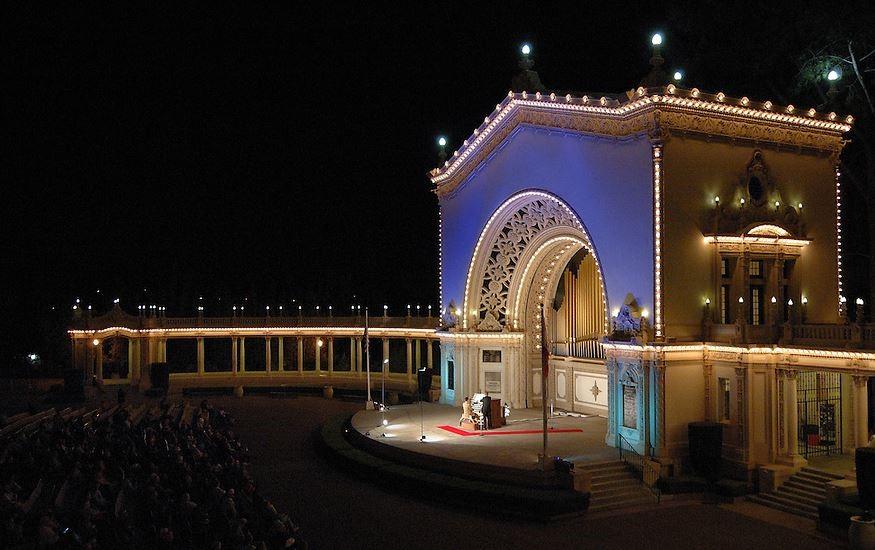
'In [Issue 154] we looked at the history and the technology behind the remarkable Spreckels Organ, the world's largest pipe organ in an outdoor venue. It was built in 1914 in Balboa Park , San Diego, California, and commissioned by John D. Spreckels and his brother Adolph B. Spreckels. It is still in use today, carrying on a long-time tradition of performers on the organ providing free concerts to the public.
This installment continues our conversation with Gordon Stanley, who has been involved with the care, curation and recording of the Spreckels Organ the past four years. Here, we discuss what's involved in recording the organ, what the future holds for concerts and events, and other topics.
FD: You've done a number of recordings. Can you mention how they're done…what kind of microphones and how they're arranged, what kind of recording equipment you use and so on. How do you capture the full range of sound, especially the bass? How are the pipes arranged in terms of left to right and so on? Do you get a stereo sound field?
GS: From day one, we have been focused on quality recordings. Raúl Prieto Ramírez, our civic organist, is also a bit of an audiophile and really wants the organ to shine in anything that is committed to our archives or future public consumption. I got the audiophile bug at age 11, living on Okinawa and burying myself in my dad's music collection. We were a musical household. Most of my family played piano, and I tell everyone [that] while I tried, actually, I play the tape recorder.
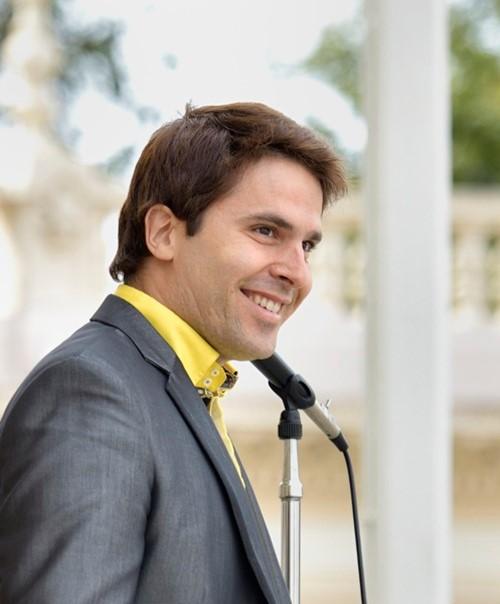
Organist Raúl Prieto Ramírez
Three years ago, I started working with Raúl, Lyle Blackinton and Dale Sorenson, all with good ears and a passion for excellence. We set [our] objectives of locating the most natural positions for microphones, selecting great equipment, and adjusting everything until we captured the true sound signature and stereo image of the organ, which is quite different from a typical church organ.
Let's start with a summary of the sound and then progress into some of the equipment, techniques and [the] trials we endured before we reached success.
The sound of the organ is relatively dry with little reverb and the sound varies greatly depending on where you sit in the pavilion. Sit on the stage and you hear the pipes, [but] miss the sounds [you hear out in] the park. Move to the stage edge and the pipes blend better but the park noises intrude, so this is a better spot for late-night recordings. Move out to the bench rows of the public seating and you land in a bass node and the 32-foot Bombardier pipe hits you in the chest like a fastball. It is fun [to experience], but overwhelms when recording. And finally, move to the edges of the stage or pavilion and the sound becomes unbalanced and you lose the high frequencies. Early on, we tested the height of the microphone array and moved it about on a 1-meter square grid testing 32 [different] locations until we settled on two optimal locations, one for day/evening recordings of live events, and one for 2:00 am recordings when we wanted [our] work [do be done] for future publication with the best [sonic] blend and [the] most quiet background. The early-morning time slot takes advantage of the moratorium on flights at the San Diego International Airport, [which came about because of] legal action by affected residents.
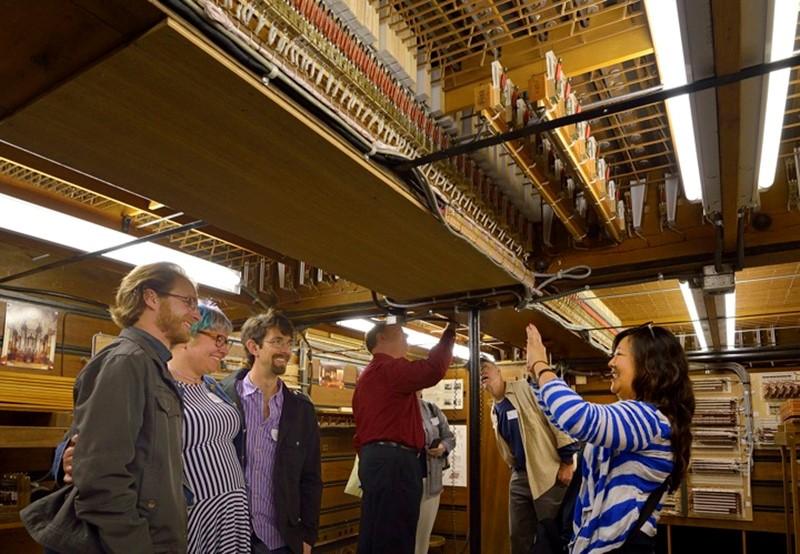
The windchest of the Spreckels Organ is so large that people can stand inside it.
While testing locations, we also reviewed the response [patterns] of the microphones. We tried DPA, Schoeps and Earthworks [mics] in both omni and cardioid configurations. Our preference was for the DPA and Schoeps. but we have currently settled on Earthworks because of a great relationship with the company and the need to balance our budgets. Even [so], we have about $7,000 tied up in mics, and given the chance, the number would rise to $15,000 as we [have] worked to acquire a multi-channel [recording] setup. The mics are in a semi-permanent array on a giant 8-meter Manfrotto camera stand, and the entire stand is weighted with 150 pounds of sandbags for safety when the wind picks up. Generally, we don't try recording if the wind exceeds 5 to 6 miles per hour because of the rumble,
Today the mic array is as follows: two Earthworks QTC-40 omnis spaced about 14 inches apart and separated by a Jecklin disk to create stereo separation in frequencies above 400 Hz. This pair of mics [has a] flat [frequency response] ranging from 6 Hz to 40,000 Hz, with a small 3 -5 dB rise in the mid-high frequencies. This is typical of most omnis designed for distant pickup of classical music. The sensitivity at 6Hz really shines in picking up every nuance of the big pipes. This is mostly felt [rather than heard], but we know it's captured, and want to keep it in our archives for when we have opportunities for excellent audio playback quality.
Below the omnis, we have a pair of Earthworks SR40 cardioid mics, spaced 14 inches apart with nothing between them. They are great at giving us a little more delineation in the highs and enhancing the stereo separation. They are flat plus or minus 2 – 3db from 20 Hz to 20,000 Hz. Typically, we use about 70 to 80 percent omni and 20 to 30 percent cardioid, just enough to give us the extra separation.
Finally, we have a Schoeps MSTC 64 ORTF mic pair in a permanent setup with spacing of 7 inches and the heads angled to 95 degrees, a wide ORTF [pattern]. This pair is faced to the audience for recording the audience, applause and park ambience on the occasions where it belongs. This pair is used less than 5 percent of the time, but when used, is a lifesaver at bringing some of the live audience feel back into a program. This was particularly helpful [during] all of 2020 and early 2021 when we were videotaping and premiering tape-delayed [broadcasts] of the concerts.
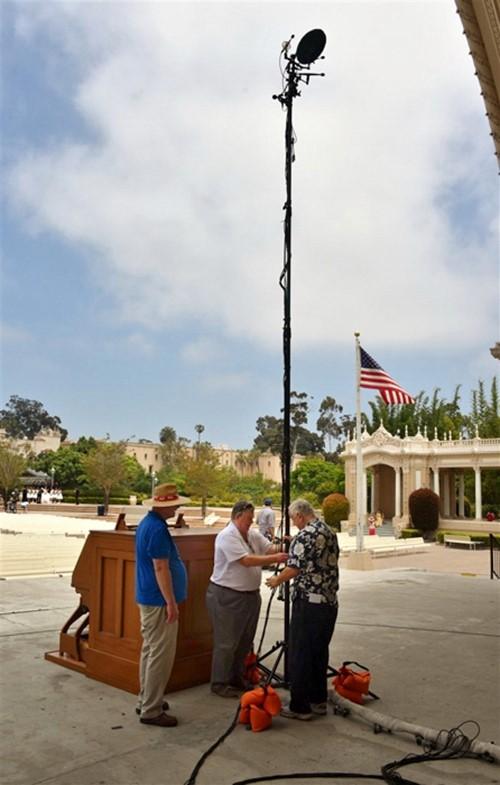
Setting up mics for recording.
While we were perfecting our mic techniques and systems, we faced two other issues. What would we use to capture the recordings, and how would we monitor and play back?
Let's begin with monitoring and playback. Being an audiophile, I have a collection of systems in my house specifically for monitoring. My office has a nearfield system, [with a] tube amp, DAC, and Boston Acoustics CR7 loudspeakers, a nice, fairly flat, slightly “slow” speaker good for classical music. I have about 20 of them spread around the house, including a bunch in a 9.2.2 surround system. I have used them for over 15 years and they make a decent monitor for classical music. I assembled a line mixer, a 200 watt-per-channel SAE amp and a pair of the CR7 speakers to take out to the pavilion for on-site monitoring [but] found them to be inadequate in level, even [when listening] behind two solid doors in the green room of the pavilion. The result was a pair of blown woofers, and now I am looking for something more robust to handle the low levels for on-site monitoring. For now, I rely on Sennheiser HD 280 Pro closed-back headphones.
In addition, I use the playback system in my master bedroom, [which includes] a Yamaha receiver and Boston Acoustics CR7 and CR85 I consider this a midrange-[quality] home system and use it to check mixes to see how the typical listener might experience the recordings.
I also have a range of headphones including Shure in-ear monitors, Sennheiser HD 280 Pro closed-back headphones (used on site), and finally a pair of Koss ESP-950 electrostatic open back headphones. Each of these are familiar old friends and help me judge the mixes.
In the end, I have two high-end systems that are the final arbiters, especially for listening to overall balance and depth, placement of instruments, delay, and so on. The first of these systems is in my mix room, [with] modified Carver M-1.5t amps, and a pair of Dynaco Mark VI tube amps biased for Class A. These drive a pair of Dynaudio Focus 340s and a pair of REL Strata III subwoofers in a sound-treated mixing room. The preamp [would be] a Trident 78 [16-channel] mixing board or a modified Carver C-1 preamp in a room [that is] custom-treated by GIK Acoustics. Much of this equipment is classic, 15 – 20 years old or older. Some is updated, and all [of it] is lovingly cared for.
For the final system, [located] in the living room [and used for listening] as a break from the [main] mixing room, audio is fed via the Trident 78 mixer or via computer files managed by Roon, sent to a Mytek Brooklyn DAC+ wired directly to a Krell FPB 600 amp, which coasts while it provides 1,200 watts per channel of Class A goodness at 4 ohms to my speakers. As an aside, it makes a great heater in the winter and punishes me during the San Diego summers, but it's worth it for the sound. The speakers are custom-modified Phase Linear (Bob Carver-designed) Andromeda III speakers. These are bipolar panel speakers with a subwoofer, and are flat more or less from 22 to 22,000 Hz. I have found [that] when I get the mix right, it sounds good no matter which system [I listen on], just better, more dynamic and more real as I move to the higher-end systems. Both rooms have over 100 amps of dedicated power circuits to give me top-notch sound. And next on the wish list is a plan to further clean up the power with PS Audio PowerPlants.
So that was a deep breath and long story about monitoring. You might ask, what am I doing to capture and archive these marvelous recordings? I begin with the wire to get from [the] mic to [the] preamp and throughout the mixing room. I have settled on two brands. I use KOPUL Premier Quad 5000 Series cables for mic cables that get beat up. In my book they are just as good as Canare and Mogami and quite a bargain. In the mixing room, everything is Mogami Gold for one consistent sound.
The recording chain begins with all the mics feeding into a mic splitter. The pass-through goes directly into a Millennia HV-3D/8 8-channel preamp. The balanced transformer splits go to front of house sound when needed. These pass into a group of four synchronized Tascam DA-3000 recorders, and tracks are usually laid down in double-DSD [format] at 5.6 MHz. For the highest quality, I can play the eight tracks back into the Trident 78/16, [and] touch [them] up with a series of analog effects including a Dangerous Music BAX EQ, Dangerous compressor, Lexicon PCM 92 (reverb and effects processor), and Bricasti Design Model 7 reverb processor. The finished mix is then fed to a fifth Tascam DA-3000. For critical measurement, I recently acquired a Dorrough meter so I can keep a super-close eye on levels. All of this equipment is in ATA road racks so they can easily go to the pavilion or other venues for recording, and back to the mix room for playback and mixing. Recently we took the system on the road to record Raúl Prieto Ramirez and Jaebon Hwang, both organists featured in the 2021 American Guild of Organists virtual convention.
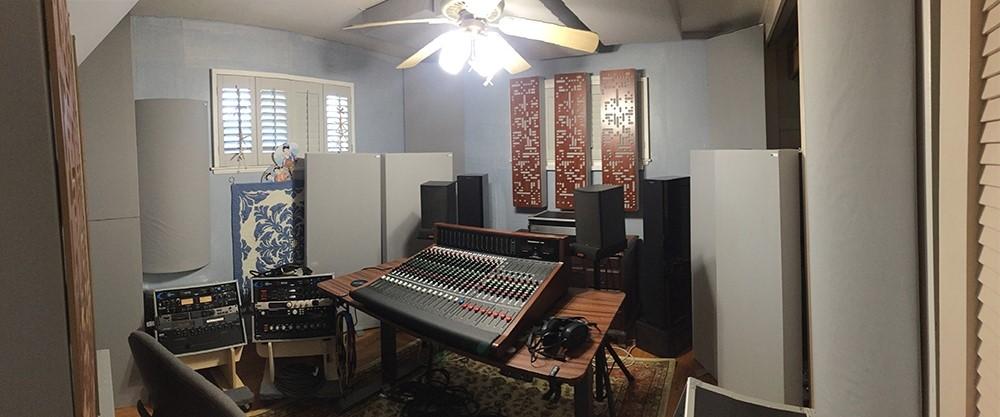
The mixing studio with GIK acoustic treatment and the effects rack (left), and the recording rack in place (lower right corner). The mixing console is a Trident-78-16. The monitor speakers are Boston Acoustics CR7 and Dynaudio Focus 340, powered by a pair of modified Carver M1.5t amps. REL Stratus III subwoofers are hidden behind the panels.
FD: So where do you go from here?
GS: As a show of support this past winter, the Trustees of the Spreckels Organ Society donated a nice sum that is allowing us to fully implement a Merging Technologies 24-track DSD Pyramix/Horus recording system. Granted, 24 tracks are generally overkill, but we have done several 16-track recordings and look forward to being able to [use this system to] record our annual concert, where we combine a rock and roll band with the organ. I am working with two dedicated volunteers, Elaine Conway and Dennis Fox, who have spent the year doing all the typical audio apprentice tasks and will soon be running the system themselves. [That's] because we are big believers in having succession plans.
FD: What recordings are currently available and what's planned for the future?
GS: We have some exciting plans for the next couple of years. We are quietly working with a well-known DSD label with the goal of publishing more of our recordings and offering them as high-quality downloads in DSD and PCM. We have found that some organists are focused mainly on the music, but a large portion of them, given the opportunity to hear [good sound] quality, become enamored and, next thing you know, we have another audiophile.
Additionally, Raúl and I are developing plans for a series of recordings to highlight some of the amazing organs in Southern California, and then we have plans to expand that program to highlight some favorites on a national scale, and if all goes well, we will highlight some of the best organs in Europe. Stay tuned for developments in this arena in 2022.”
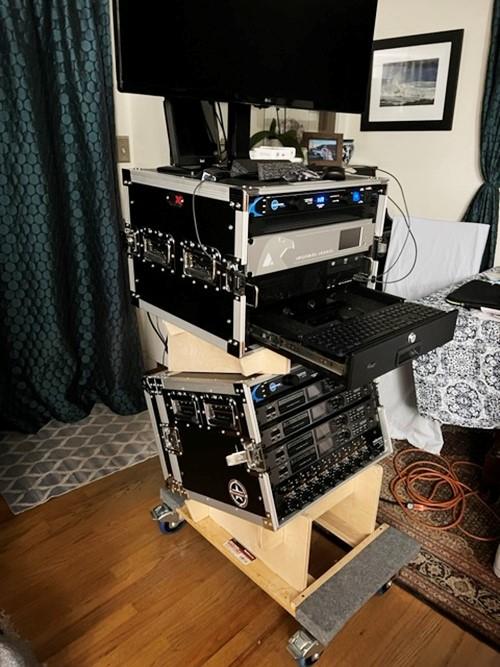
The recording system with the latest modifications, including a computer and Merging Technologies Pyramix/Horus interface that will allow up to 24 tracks of quad-DSD recording.
. . . . .
Acknowledgments: Special thanks to Jean Samuels, 2019-2021 Society president; Dale Sorenson, curator; Mitch Beauchamp, trustee; and Robert E. Lange, photographer, who were instrumental in making this article and interview happen.
